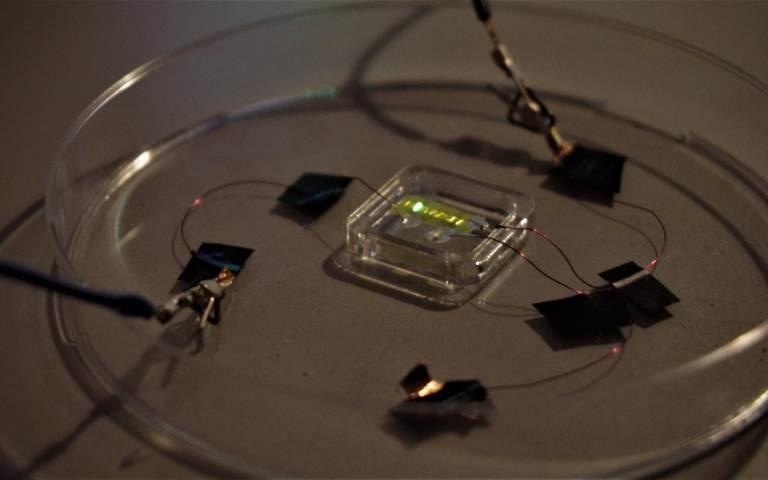Mar 1 2021
Researchers from University College London (UCL) and the Istituto Italiano di Tecnologia (Italian Institute of Technology—IIT) have made a temporary tattoo using light-emitting technology found in smartphone and TV screens. The study sets the stage for a new kind of “smart tattoo” with several possible applications.
 OLED tattoo. Image Credit: Barsotti—Italian Institute of Technology.
OLED tattoo. Image Credit: Barsotti—Italian Institute of Technology.
The technology involves using organic light-emitting diodes (OLEDs) and is applied similarly to water transfer tattoos. This means that the OLEDs are fabricated onto temporary tattoo paper and then moved to a new surface by pressing on to it and dabbing with water.
According to the team, the new tattoo could be integrated with other tattoo electronics to, for example, discharge light when an athlete gets dehydrated, or when one needs to get out of the sun to prevent sunburn. The process has been explained in a new paper published in the Advanced Electronic Materials journal.
OLEDs can be tattooed on fruit or packaging to signal when a product has expired or will soon turn inedible, or utilized for fashion as glowing tattoos.
The tattooable OLEDs that we have demonstrated for the first time can be made at scale and very cheaply. They can be combined with other forms of tattoo electronics for a very wide range of possible uses. These could be for fashion—for instance, providing glowing tattoos and light-emitting fingernails. In sports, they could be combined with a sweat sensor to signal dehydration.
Franco Cacialli, Study Senior Author and Professor, Physics and Astronomy, University College London
“In healthcare they could emit light when there is a change in a patient’s condition – or, if the tattoo was turned the other way into the skin, they could potentially be combined with light-sensitive therapies to target cancer cells, for instance,” added Cacialli.
Our proof-of-concept study is the first step. Future challenges will include encapsulating the OLEDs as much as possible to stop them from degrading quickly through contact with air, as well as integrating the device with a battery or supercapacitor.
Franco Cacialli, Study Senior Author and Professor, Physics and Astronomy, University College London
The OLED device developed by the team measures 2.3 μm thick in total (less than 1/400 of 1 mm)—about a third of the length of a single red blood cell. It includes an electroluminescent polymer (a polymer that discharges light when an electric field is employed) in between electrodes. An insulating layer is positioned in between the commercial tattoo paper and the electrodes.
The thickness of the light-emitting polymer is around 76 nm (a nanometer is a millionth of a millimeter) and was made utilizing a method known as spin coating, where the polymer is applied to a substrate that rotates at high speed, thereby generating an extremely thin and even layer.
As soon as they had developed the technology, the team coated the tattooable OLEDs, which discharged green light, onto a pane of glass, an orange, paper packaging, and a plastic bottle.
Tattoo electronics is a fast-growing field of research. At the Italian Institute of Technology we have previously pioneered electrodes that we have tattooed onto people’s skin that can be used to perform diagnostic tests such as electrocardiograms. The advantage of this technology is that it is low-cost, easy to apply and use, and washes off easily with soap and water.
Virgilio Mattoli, Study Senior Author, Professor and Researcher, Italian Institute of Technology
Initially, OLEDs were used in a flatscreen TV 20 years ago. The benefits of the technology are that they can be utilized on bendy surfaces, flexible, and that they can be made from liquid solvents. This implies they are printable, offering an inexpensive method to make tailored new OLED designs.
Journal Reference:
Barsotti, J., et al. (2021) Ultrathin, Ultra‐Conformable, and Free‐Standing Tattooable Organic Light‐Emitting Diodes. Advanced Electronic Materials. doi.org/10.1002/aelm.202001145.